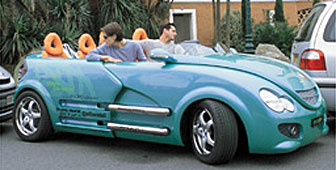
Hey Presto! The incredible shrinking car

If one car at this year's Geneva Motor Show demonstrates the industry's need to combine style with innovative technology, it's the "Presto".
One of the more remarkable things about the Presto is its country of origin – Switzerland, a place with virtually no motor industry to speak of. It is made by Rinspeed, a Zurich-based company that specialises in producing prototypes and concept cars.
The Presto has been described as “the incredible shrinking car”, because its most eye-catching innovation is that its length can be transformed at the press of a button. It can be converted in about ten seconds from a 3.7 metre four seater into a funky two-seater roadster measuring less than three metres.
Best of both worlds
“Most people like the Smart. It’s a great car for commuting and for parking in cities,” says Frank Rinderknecht, Rinspeed’s owner. “But at the weekends, when you need to do your shopping or take your mother-in-law out, you need a bigger car. With the Presto, you have the best of both worlds.”
But this versatility is not the Presto’s only innovation. Like many of the companies exhibiting in Geneva, Rinspeed has been looking at alternative forms of fuel.
The Presto runs on a combination of diesel and natural gas, which produces cleaner emissions than a petrol engine. Rinderknecht sees this as a useful stopgap until fuel cell-driven cars – in which battery-like devices convert hydrogen and oxygen into electricity and heat – become more widely available.
“Realistically, the fuel cell is still 30 years away. So we need something in the meantime, and natural gas is a good realistic alternative,” he told swissinfo.
Commercialising concepts
Rinderknecht describes his company as an “ideas factory”. It is up to other bigger companies to take his concepts and commercialise them. That is one of the principal reasons for exhibiting in Geneva.
“We’re hoping for a domino effect, where a big manufacturer picks it up and a few years down the road, someone will mass-produce it,” he says.
Of course, it is not only the small companies operating on the fringes that are looking to break new ground. Many of the big car manufacturers are also studying the viability of new sources of fuel – in response to evolving legislation and public opinion.
Fuel cell research
Volkswagen, for example has been working with the Paul Scherrer Institute (PSI), which is based in Villigen in canton Aargau, to develop a hydrogen-powered car.
Alongside the fuel cell – which converts hydrogen into electricity, with water as the only by-product – is a “super-capacitor”, a special battery that stores energy.
“This combination allows energy efficiency and high performance,” says Philipp Dietrich, head of the research project at the PSI.
He told swissinfo that the fuel cell is ideally suited to cruising over longer distances, while the capacitor -which also absorbs energy from the braking process – allows better acceleration.
by Roy Probert

In compliance with the JTI standards
More: SWI swissinfo.ch certified by the Journalism Trust Initiative




























You can find an overview of ongoing debates with our journalists here . Please join us!
If you want to start a conversation about a topic raised in this article or want to report factual errors, email us at english@swissinfo.ch.